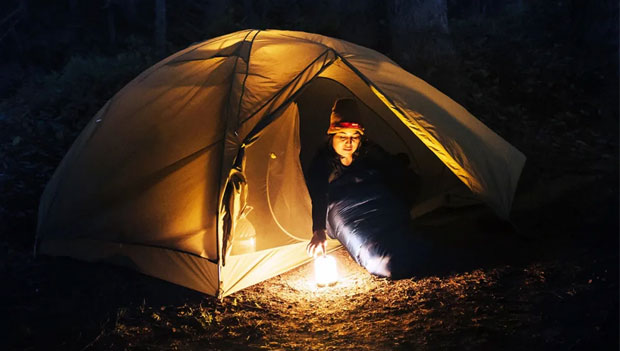
By clicking on the product links in this article, we may receive a commission fee at no cost to you, the reader. Sponsorships and affiliate commissions help support our research so we can help you find the best products. Read our full affiliate disclosure here.
If you grew up taking family camping trips, you'll remember when camping was simple. Your parents might've packed the kids and their best camping gear into the back of the family van, laced up their hiking shoes, and headed on their way.
It's that simplicity that so many of us are seeking these days, but planning your next outdoor overnight trip can feel overwhelming. Tent camping is no longer your only option. Car camping, RV camping, winter camping, and backpacking have all grown in popularity, making it hard to figure out exactly what kind of gear you need.
That’s why we did the heavy lifting for you to help you choose the best gear for your next adventure under the stars.
The Best Camping Gear - Our Top Picks
- Best Tent: Mineral King 3 Tent
- Best Sleeping Bag: Groundwork Single Sleeping Bag
- Best Sleeping Pad: Lightweight Series Air Pad - Double
- Best Camp Stove: Jetboil MiniMo Cooking System
- Best Cooler: Yeti Tundra 65 Hard Cooler
- Best Camping Chair: Big Agness Big Six Camp Chair
- Best Hammock: Jungle Nest Hammock
- Best Lantern: Biolite AlpenGlow 500
- Best Headlamp: Bindi Ultralight Headlamp
- Best Hatchet: Jonaker Hatchet
Why Trust Us?
ACTIVE.com's editorial team relies on the knowledge and experience of fitness and wellness experts including competitive athletes, coaches, physical therapists, nutritionists, and certified trainers. This helps us ensure the products we feature are of the highest standard. Collectively, the team has spent countless hours researching equipment, gear, and recovery tools in order to create the most accurate, authentic content for our readers. Customer satisfaction is also a key part of our review process, which is why we only feature products that are highly rated. More importantly, each member of our team is a fitness enthusiast. Fitness may be our job, but it is also our passion. Therefore, we strive to bring you products that we trust and would personally use.
Best Tent - Mineral King 3 Tent

SPECS
- Size: 3-person capacity, interior height: 41", floor dimensions: 68" x 90", floor space: 42.5 sq. ft., packed size: 7" x 25"
- Weight: Trail weight: 6 lbs., packed weight: 7 lbs.
- Material: Fly, canopy: polyester, floor: nylon
- Special features: Spacious, venting and removable rain fly, full mesh canopy, five internal pockets, generous footprint, vestibule for dry gear storage
The Mineral King three-person Tent is built to endure three seasons: spring, summer, and fall. Made with comfort in mind, this tent has a rectangular shape and two doors that can be secured open for an extra spacious feel.
You'll enjoy sleeping under the stars with the full mesh design, but this camping tent also offers a quick and easy way to secure the rainfly in the event of a sudden storm. Plus, because it’s lightweight and compact, we also think it could be a good option to take in your backpacking pack.
PROS
- Spacious
- Mesh design promotes stargazing and optimal ventilation
- Ample pockets for storage
- Easy-to-use rainfly
- Generous-sized footprint to keep you dry and belongings clean
CONS
- Not advised for winter camping; doesn’t provide much insulation
BUY: Mountain Hardware Mineral King 3 Tent - 3-Person 3-Season
Best Sleeping Bag - Groundwork Single Sleeping Bag
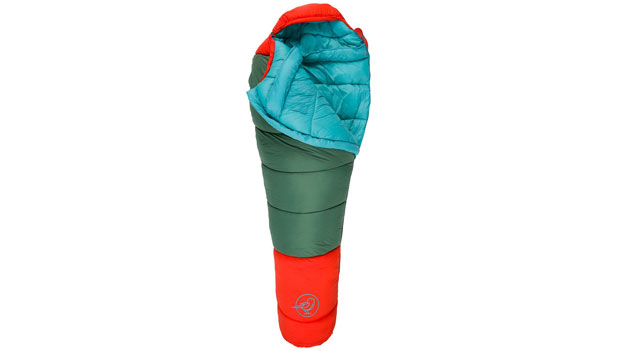
SPECS
- Size: Max user height: 6 ft., shoulder circumference: 70", hip circumference: 56", foot circumference: 40", bag length: 6 ft., stuff size: 15.5" x 10"
- Weight: 5 lbs.
- Material: Nylon
- Special features: "Mummy style" for increased insulation, lightweight, hood
Looking for a sleeping bag that’ll keep you warm and snug? The Stoic Groundwork Single Sleeping Bag is intended for temperatures that dip down to 0 degrees Fahrenheit. Its mummy shape reduces the amount of air circulating around your body, keeping you warm all night long.
The soft, lightweight fabric ensures a comfortable night's sleep regardless of the season, and a draw-string hood can be pulled around your head for those teeth-chattering, chillier nights.
PROS
- Mummy style promotes increased insulation and consistent temperatures
- Lightweight
- Soft fabrics
- Engineered for temperatures down to 0°F
CONS
- Challenging to roll over or switch positions due to dense fabric
Groundwork Single Sleeping Bag
Best Sleeping Pad - Lightweight Series Air Pad
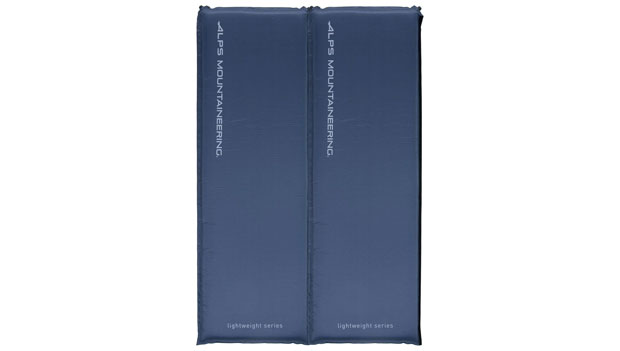
SPECS
- Size: Inflated: 75" x 47", packed: 25" x 7.5", pad-thickness when inflated: 3:
- Weight: 9 lbs.
- Material: Nylon, polyester, polyurethane open-cell foam
- Special features: Double size, self-inflating, repair kit included
The ALPS Mountaineering Lightweight Series Air Pad is perfect for couples or the camper who appreciates a little extra room to roll from side to side. We especially like the separation feature of this pad. So, if you're not looking to snuggle up with the other camper sharing your tent, these sleeping pads can be separated so that you can each have your own space. Plus, you can easily fasten them back together using the velcro strip that runs up the middle.
PROS
- Convenient double size
- Able to separate into two separate pads with ease of velcro fastener
- Easy to inflate and no extra accessories required
- 3" thickness while inflated provides ample cushioning
CONS
- Challenging to deflate
- Weight makes it too heavy for backpacking
BUY: ALPS Mountaineering Lightweight Series Air Pad - Double
Best Camp Stove - MiniMo Cooking System
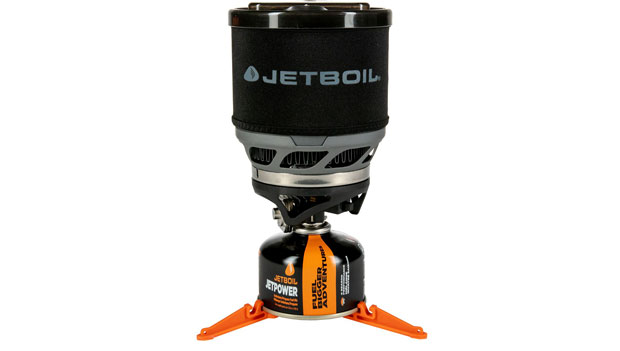
SPECS
- Size: 5" x 6"
- Weight: 1 oz.
- Material: Stainless steel (burner), metal (handles), aluminum (cup), neoprene (cup cozy)
- Special features: Compact size,54 min. burn time, 4 ½ min. boil time, easy push-button ignition
The Jetboil MiniMo Cooking System is the perfect companion for a long-distance hiker looking for a hot meal. Its lightweight and compact design will also save you space in the car and won't take up so much room at the camp table, making it a game changer in our book.
As if its size and portability of it weren't enough, it boils water in less than five minutes and comes with a cooking cup that you can use to eat or drink, eliminating the need to pack an additional bowl or cup. As an added bonus, it also comes with a built-in measuring cup as well.
PROS
- Lightweight and compact design
- Built-in drinking cup and measuring cup
- Fast boil time
- Simmer control
CONS
- Smaller capacity (single person use, two at most)
- Igniter can fail
- Other uses require purchasing additional adapters
BUY: Jetboil MiniMo Cooking System
Best Cooler - Yeti Tundra 65 Hard Cooler

SPECS
- Size: 30.6"W x 17.3"D x 16"H (external dimensions), 23.1"W x 10.6"D x 11.1"H (internal dimensions)
- Weight: 29 lbs.
- Material: UV-resistant polyethylene
- Special features: Capacity of up to 42 cans (2:1 ice-to-can ratio) or 52 lbs. of ice, can be used with dry ice, grizzly-proof design
If you've ever unloaded a cooler from the car that’s already left a pool of condensation behind, you'll understand why the YETI Tundra 65 Hard Cooler is our top choice for keeping your drinks and food cold no matter what the temperature outside is. While the YETI brand is known for its premium cooling abilities, this cooler can also keep food hot.
It can hold 42 cans or up to 52 pounds of ice, making it the perfect companion to keep the cold beverages coming during your weekend in the woods. The bottom of the cooler has non-slip feet so it'll stay in place if you bring it along on the boat, ATV, or whatever mode of transportation you choose for your outdoor adventure.
PROS
- Good for maintaining temperatures for cold or hot items
- Durable design
- Leakproof
CONS
- Expensive
- Can get heavy when packed full
BUY: Yeti Tundra 65 Hard Cooler
Best Camping Chair - Big Agnes Big Six Camp Chair
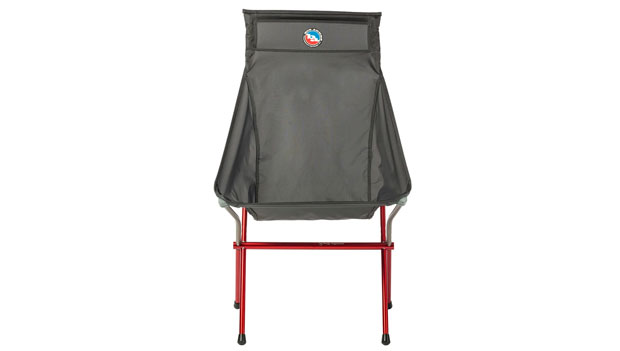
SPECS
- Size: 24"W x 20"H
- Weight: 3 lbs.
- Material: Aluminum (frame), polyester oxford with polyurethane coating (print material), Robic™ nylon with polyester ripstop (solid colored)
- Special features: Simple set-up and breakdown, self-equalizing center poles for uneven ground, carry bag included
If you're looking for a lightweight, compact camping chair that can be set up and put away in a flash, we recommend the Big Agnes Big Six Camp Chair. Thanks to its compact size, this chair can be kept in the car at all times so you'll never be without a place to sit wherever your adventures take you: camping, festivals, or a picnic. When it comes to comfort and convenience, this chair offers the best of both worlds.
PROS
- Easy setup and breakdown
- Lightweight and compact when packed
- Comfortable
CONS
- Expensive
- Can be difficult to stand up depending on abilities/mobility
BUY: Big Agnes Big Six Camp Chair
Best Hammock - JungleNest Hammock

SPECS
- Size: 10" x 5" x 5" (packed), 10' x 4'10" (unpacked)
- Weight: 20 oz. (hammock and bug net), 24 oz. (with suspension straps)
- Material: Nylon, mesh
- Special features: Holds up to 300 lbs., optional mesh bug net
If you're looking to truly camp under the stars, the ENO JungleNest Hammock offers protection from the bugs while providing a comfortable place off the ground to rest your eyes. This is a more affordable, yet comparable, option when lined up next to other high-end brands and models often touted in the backcountry.
While the mesh bug net can't be completely removed, it can be unzipped if bugs aren't a concern and you're looking for a starry view as you fall asleep.
PROS
- Easy setup
- Bug net keeps out pests while still promoting air circulation
- Low price compared to competitor's models
CONS
- End-gathered style isn't as comfortable for side sleepers
- Hammock straps sold separately
Best Lantern: Biolite Alpenglow 500
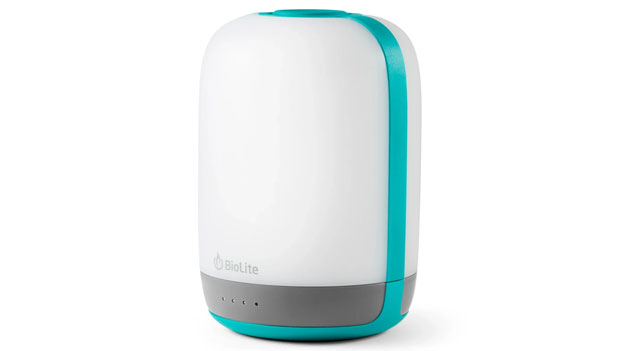
SPECS
- Size: 5.4" x 3.8"
- Weight: 13.4 oz.
- Material: N/A
- Special features: 500 lumens, USB-out charges devices, 5 hours of burn time on high, up to 200 hours on low, single color or multi-color options
Whether you need to light up your entire tent or the stars just need a little help lighting your path, the Biolite Alpenglow 500 has all the settings and power you need to be kept out of the dark. With a variety of light settings and colors, the ambiance is in your hands whether you're in the mood to relax or rave.
This rechargeable lantern also features a convenient hook on the bottom, making it easy to hang in your tent or wherever you find yourself needing to be hands-free.
PROS
- Multiple color options
- Long runtimes
- Ability to charge other devices via USB
CONS
- On the pricier side
- Charged via micro USB rather than more common USB C input
Best Headlamp - Bindi Ultralight Headlamp

SPECS
- Size: 6" x 4" x 2"
- Weight: 1.23 oz.
- Material: N/A
- Special features: 200 lumens, weather resistant, rechargeable battery, adjustable
As mentioned in its title, the Bindi Ultralight Headlamp is perfect for those looking to lighten their load in the backcountry. With three light modes, you can easily choose what you need at the moment. This little headlamp was built to light your way through a variety of activities whether you're trail running or reading a book before you fall asleep. We can't recommend this enough when it comes to a lightweight and comfortable headlamp for your after-dark outdoor adventure.
PROS
- Minimalist design
- Lightweight and compact
- Offers three lighting modes
- Weather resistant
CONS
- Not recommended for long or continuous use
- Headband might take some getting used to
BUY: Bindi Ultralight Headlamp
Best Hatchet - Jonaker Hatchet
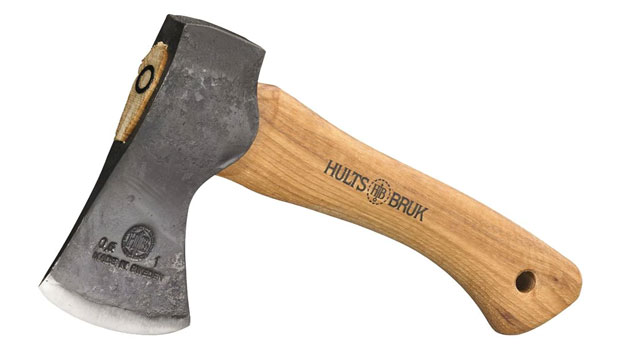
SPECS
- Size: 9.4" (handle), 4" (blade), 2.7" (cutting edge)
- Weight: 1.5 lbs.
- Material: Steel (blade), wood (handle)
- Special features: Compact, protective sheath included
A perfectly portable hatchet for your outdoor adventure, the Hults Bruk Jonaker Hatchet was made to split kindling, cut through some brush blocking your path, or carve yourself a nice hiking stick out of the perfect branch you found along your route.
We like how it’s made from high-quality Swedish ax steel, which is proven to hold a sharp edge after repeated use, making it the best lightweight companion for long backcountry hikes.
PROS
- Lightweight and packable
- Includes protective sheath
- Sharp edge holds after repeated use
CONS
- Pricier than other options
- Not recommended for heavy-duty jobs
What to Look for in Camping Gear
To get started, we suggest you focus on the essentials (shelter, food, safety, warmth, and light) while keeping camping etiquette top of mind. Once you've decided what kind of camping trip you want to take, you'll need to consider the following factors when it comes to your gear:
Purpose and Weight
The first thing to consider is what kind of camping trip you want to do. Can you drive right up to your campsite? Or will you need to hike and haul your gear in on your back?
Once you've decided whether you're car camping or backpacking, you'll know whether you need to pack on the lighter side or if you need space for more gadgets and accessories, like trekking poles or outdoor speakers. Do you plan on doing any activities like climbing or fishing? Consider this type of gear as well.
Durability
Do you plan to camp every weekend? Or is this more of an annual outing?
The more durable your gear, the pricier it can be. However, if you're a fair-weather camper, you might not need to splurge for the gear that can withstand the wettest and windiest conditions. Of course, camping in the middle of nowhere is the last place you want to find yourself unprepared, so durability is an important consideration.
Mobility and Transport
Camping gear isn't always lightweight or compact. It's often awkward or bulky, so think ahead to what you have planned for your trip as well as your own abilities. Let's consider a full cooler, for example. Will you be able to lift it, or are you going to need a cooler with wheels? Asking yourself questions like this, and creating a vision for how you’d like to set up camp with each item can help you decide what works best for you.
FAQs About Camping Gear
How do you carry water when camping?
There are a number of jugs of varying sizes that you can buy to carry water while camping. We recommend purchasing a reusable jug to stay hydrated.
It's also not a bad idea to always have a supply of water purification tablets with you. These come in handy if you're at a more primitive campsite, or you find that running water has been turned off for the season. You can also carry these with you on hikes in case of an emergency.
What do I need for a 3-day camping trip?
The list we've provided above is a great place to start when it comes to the essentials.
In addition to those basics, here are a few other things you'll want to consider:
- First-aid kit
- Duct tape
- Utility knife
- Matches/lighter
- Water purification tablets
- Camping pillow
- Camp table (if your campsite doesn't include a picnic table)
- Fuel and/or batteries
- Small broom/dust pan
- Matches/fire starter
- Kitchen supplies (plates, utensils, etc.)
- Wash bin
- Biodegradable soap
- Garbage bags
- Bottle opener/corkscrew
Do I need a tarp under my tent?
While not required, we do recommend using a tarp under your tent. Adding an extra layer of protection under your tent can help keep you and your belongings dry from condensation and morning dew, keep you warmer, and minimize the wear and tear on the bottom of your tent from rocks and sticks. It can also help keep your tent clean. It's easier to spray down a tarp to rid it of dirt and pine needles when you get home than to spray down and dry the tent itself.
Keep in mind that some tents, including the Mineral King 3 Tent we recommend above, come with a tent footprint (a built-in layer of protection between the tent and the ground), so in that case, a tarp isn't necessary.
What is the best food to bring on a camping trip?
The best kinds of food to bring on a camping trip are those that are easy to store and easy to make at camp. But, it also depends on what kind of gear you plan to bring with you. If you're planning to pack a camp stove, plates, bowls, utensils for cooking hearty meals, the sky's the limit.
If you prefer to pack a little bit lighter, consider bringing food like hotdogs or brats to cook over the fire, fixings for sandwiches, and dehydrated meals that don't require a lot of prep and extra equipment.
As far as snacks go, you can't go wrong with things that stay good in a variety of conditions: trail mix, bars, nuts, beef jerky, and dried fruits to name a few.
What if it rains while camping?
If it rains while you're camping, embrace it. The easiest way to do this is to have a plan. Make sure your rain fly is secure over the tent, and bring a tarp if your tent doesn't come with a footprint. Secure your belongings to keep them dry (don't forget to cover up the firewood), and then sit back and enjoy the show from the comfort of your vehicle or tent. There is nothing quite like the soothing sound of raindrops hitting your tent as you fall asleep. If you're in for an afternoon of rain showers, come prepared with a deck of cards, a game, or a good book.
If you're really worried about the rain, make sure to come prepared and set up camp accordingly:
- By a waterproofing spray and a seam sealer to treat your tent with to ensure it's ready for whatever weather nature brings.
- Pitch your tent on higher ground.
- Pack extra tarps to put under your tent, cover up your wood/kindling supply, or tie to a tree for additional shelter.
- Pack a spare set of clothing (socks, pants, shirts) in case you get caught in the downpour.
How do I protect my tent floor?
We recommend putting a tarp between your tent and the ground to keep your tent dry and to prevent the wear and tear that often comes from rocks and sticks over time. We also recommend waterproofing the tent floor just for an added measure of protection.
On the inside, keep a handheld broom and dustpan handy and keep the inside of your tent clean. Not only will keeping a clean tent help it last longer, but it makes for a better camping experience. And if you've decided to purchase a cot to keep you off the ground, be careful to make sure the legs of your cot don't tear up the floor of your tent. Holes or cuts will let in moisture, and moisture inside the tent can put a damper on your trip.
Why is bringing extra clothes on a camping trip important?
Packing a few extra layers helps you stay prepared for a variety of temperatures and weather, and staying dry is essential to staying healthy. Mother Nature is unpredictable, but if you plan ahead and prepare, you'll be able to make the most out of your time in the great outdoors.
What are the 10 essentials for camping?
It all comes down to preparedness. Here is what we recommend you bring and consider:
- Shelter (protection from the elements)
- Insulation (extra layers, rain jacket)
- Light (flashlight, firestarter)
- Repair kit (for tent, tires, inflatables)
- First-aid kit
- Navigation tools (map, GPS)
- Hydration (water purification tablets in case of emergency)
- Food
- Knife/multi-tool
- Sun protection (sunscreen, sunglasses)


